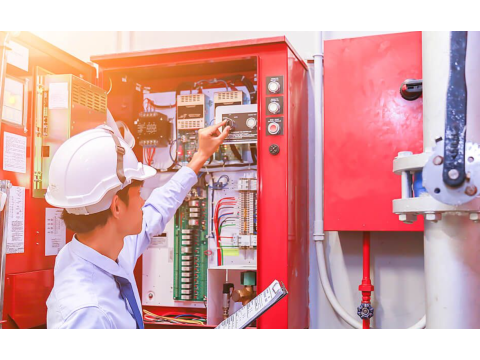FIRE ALARM MAINTENANCE: EVERYTHING YOU NEED TO KNOW
MAINTENANCE TYPES
REPAIR OPTIONS
DOCUMENTATION REQUIREMENTS
Fire alarm maintenance is essential for keeping your system operational under any circumstances. Regular and proper servicing helps detect and fix equipment issues, preventing malfunctions during a fire. Fire alarm maintenance is divided into two main categories:
1. Scheduled Maintenance
Occurs monthly and is recorded in a dedicated logbook. Each visit by the service provider is logged meticulously. Scheduled maintenance involves:
- Regular inspections as outlined in Regulation #1 and Regulation #2 (discussed below).
- Preventive measures, such as sensor cleaning and battery capacity checks.
2. Unscheduled Maintenance
Performed in case of false alarms, equipment failures, external impacts, or customer complaints. This type of maintenance follows Regulation #2 and is also recorded in the logbook.
Upon installation, the contractor provides the client with an operation manual and additional documents, including:
- A maintenance checklist.
- A fault log.
- A service agreement.
Typically, the installer offers ongoing maintenance, but the client can choose another licensed service provider. It's crucial that the chosen company holds an official license from the local fire authority, ensuring high service standards.
MAINTENANCE REGULATIONS
Maintenance regulations define the mandatory steps, periodicity, and scope of work for servicing fire alarm systems. These include equipment checks, visual inspections, sensor cleaning, and performance testing.
Clients receive these regulations as part of the system's documentation after installation. Reviewing the regulations helps ensure the service provider fulfills their obligations.
Fire alarm systems follow two main regulations:
Regulation #1
Includes:
- Visual inspection and testing of all system components.
- Fixing identified issues.
- Preventive tasks, like sensor cleaning.
- Testing backup power sources, including battery capacity measurements.
This work is carried out at least once a month.
Regulation #2
Covers everything in Regulation #1, plus:
- Advanced preventive measures, such as interference testing and parameter measurements.
- Ensuring system compliance with technical specifications.
- Following additional manufacturer recommendations.
Work under Regulation #2 occurs quarterly.
Important: Non-compliance with these regulations by the service provider is unacceptable and may compromise system reliability.
FIRE ALARM SYSTEM REPAIR
If maintenance reveals equipment issues, repairs are mandatory. Repairs are classified into three types:
1. Routine Repair
- Restores system functionality by inspecting and replacing faulty components like sensors and cables.
- Address detected faults promptly based on client requests or maintenance findings.
2. Preventive Repair
- Fixes all issues identified during regular system use.
- Includes sensor replacement, backup battery renewal, and other necessary updates.
- Tailored to the equipment's design specifics.
3. Overhaul
- Performed after structural renovations or when the system has reached its lifespan.
- Involves replacing all wiring, power lines, sensors, and devices.
- Includes system recalibration and testing post-repair.
Repairs must be conducted by licensed professionals with appropriate certifications.
DOCUMENTATION FOR FIRE ALARM MAINTENANCE AND REPAIR
Clients must retain the following documents:
Maintenance Schedule:
- Lists monthly and quarterly tasks.
- Indicates service dates, system types, and tasks performed.
Work Log:
- Details service dates, system types, and elements serviced.
- Records component replacements and system status after maintenance.
- Includes client and service provider signatures.
Repair Documentation Includes:
- Acceptance Act: Lists replaced components, installation details, and testing results.
- Equipment Inventory: Includes device names, types, serial numbers, and quantities.
- Resistance Measurement Protocols: Ensures wiring integrity.
Additional documents may include inspection reports, technical re-certification acts, false alarm logs, wiring diagrams, and staff instructions.
STAFF TRAINING AND RESPONSIBILITIES
All employees in buildings with fire alarm systems must be familiar with the system's operation and general fire safety rules. Management should designate responsible individuals to monitor system performance and report any issues.

